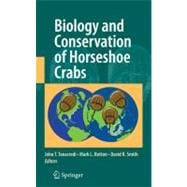
What is included with this book?
| Biology | |
| A Populations and Habitats | |
| Limits on the Global Distribution of Horseshoe Crabs (Limulacea): Lessons Learned from Two Lifetimes of Observations: Asia and America | p. 5 |
| Horseshoe Crabs-An Ancient Ancestry Revealed | p. 25 |
| The Ecological Importance of Horseshoe Crabs in Estuarineand Coastal Communities: A Review and Speculative Summary | p. 45 |
| Relationships Between Sandpipers and Horseshoe Crab in Delaware Bay: A Synthesis | p. 65 |
| Horseshoe Crabs, Their Eco-biological Status Along the Northeast Coast of India and the Necessity for Ecological Conservation | p. 89 |
| American Horseshoe Crabs, Limulus polyphemus, in Mexico:Open Possibilities | p. 97 |
| Basic Habitat Requirements of the Extant Species of HorseshoeCrabs (Limulacea) | p. 115 |
| The Relationship Between Small- and Large-Scale Movementsof Horseshoe Crabs in the Great Bay Estuary and Limulus Behaviorin the Laboratory | p. 131 |
| Ecology of Horseshoe Crabs in Microtidal Lagoons | p. 149 |
| Phylogeography, Demographic History, and Reserves Network of Horseshoe Crab, Tachypleus tridentatus, in the South and EastChina Seaboards | p. 163 |
| Genetic Structure of Japanese Populations of Tachypleus tridentatus by mtDNA AT-Rich Region Sequence Analysis | p. 183 |
| Reproduction, Physiology, and Development | |
| Reproductive Competition and Sexual Selection in Horseshoe Crabs | p. 199 |
| Vision in Horseshoe Crabs | p. 223 |
| Sperm Attachment on the Egg of Malaysian King Crab,Carcinoscorpius rotundicauda | p. 237 |
| Distribution and Development of Limulus Egg Clusters on Intertidal Beaches in Delaware Bay | p. 249 |
| Comparisons in Prosomal Width and Body Weight Among Early Instar Stages of Malaysian Horseshoe Crabs, Carcinoscorpiusrotundicauda and Tachypleus gigas in the Laboratory | p. 267 |
| Emergence Behavior of Juvenile Tachypleus tridentatus Under Simulated Tidal Conditions in the Laboratory and at Two DifferentSediment Temperatures | p. 275 |
| Distribution of Juvenile Horseshoe Crabs in Subtidal Habitatsof Delaware Bay Using a Suction-Dredge Sampling Device | p. 285 |
| Conservation | |
| Commercial Use and Management of Populations and Habitat | |
| History of Horseshoe Crab Harvest on Delaware Bay | p. 299 |
| Biomedical Applications of Limulus Amebocyte Lysate | p. 315 |
| The Effect of Hemolymph Extraction Volume and Handling Stresson Horseshoe Crab Mortality | p. 331 |
| Horseshoe Crabs in Hong Kong: Current Population Statusand Human Exploitation | p. 347 |
| Comparative Status and Assessment of Limulus polyphemus with Emphasis on the New England and Delaware Bay Populations | p. 361 |
| An Integrative Approach to Horseshoe Crab Multiple Useand Sustainability | p. 387 |
| Strategies to Conserve and Enhance Sandy Barrier Habitatfor Horseshoe Crabs {Limulus polyphemus) on Developed Shorelinesin Delaware Bay, United States | p. 399 |
| Conservation Program for the Asian Horseshoe Crab Tachypleus tridentatus in Taiwan: Characterizing the Microhabitat of NurseryGrounds and Restoring Spawning Grounds | p. 417 |
| The Effects of Water Quality on Horseshoe Crab Embryos and Larvae | p. 439 |
| Heavy Metal Concentration in Horseshoe Crab {Carcinoscorpiusrotundicauda and Tachypleus gigas) Eggs from Malaysian Coastline | p. 455 |
| A Discussion of Horseshoe Crab Management in Five Countries:Taiwan, India, China, United States, and Mexico | p. 465 |
| Culture and Captive Breeding | |
| Clinical Evaluation, Common Diseases, and Veterinary Careof the Horseshoe Crab, Limulus pofypkemus | p. 479 |
| Aquaculture Methods and Early Growth of Juvenile Horseshoe Crabs (Limulus polyphemus) | p. 501 |
| Larval Culture of Tachypleus gigas and Its Molting Behavior Under Laboratory Conditions | p. 513 |
| Diet Composition of Juvenile Horseshoe Crabs: Implicationsfor Growth and Survival of Natural and Cultured Stocks | p. 521 |
| Effect of Sediment Type on Growth and Survival of Juvenile Horseshoe Crabs (Tachypleus tridentatus) | p. 535 |
| Public Awareness and Community-Based Conservation | |
| The Conservation Network of Horseshoe Crab Tachypleus tridentatus in Taiwan | p. 543 |
| The History of Horseshoe Crab Research and Conservation in Japan | p. 559 |
| Public Awareness and Community-Based Conservation for the Horseshoe Crab at Saikai National Park in Nagasaki Prefecture, Japan | p. 571 |
| Public Participation in Studies on Horseshoe Crab Populations | p. 585 |
| Green Eggs and Sand: A Collaborative Effort of Scientists, Teachers, Resource Managers, and Stakeholders in Educating About Limulus polyphemus | p. 595 |
| Community Building: An Integrated Approach to Horseshoe CrabConservation | p. 605 |
| Abstracts of Additional Papers and Posters Presented | p. 613 |
| Index | p. 641 |
| Table of Contents provided by Ingram. All Rights Reserved. |
The New copy of this book will include any supplemental materials advertised. Please check the title of the book to determine if it should include any access cards, study guides, lab manuals, CDs, etc.
The Used, Rental and eBook copies of this book are not guaranteed to include any supplemental materials. Typically, only the book itself is included. This is true even if the title states it includes any access cards, study guides, lab manuals, CDs, etc.